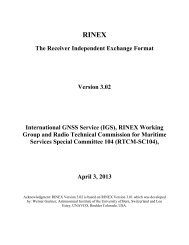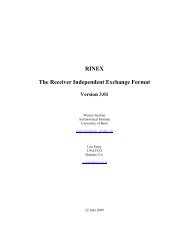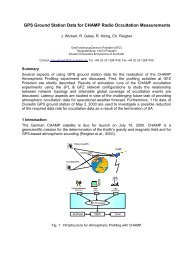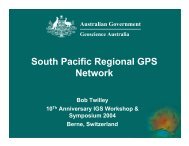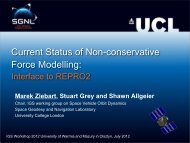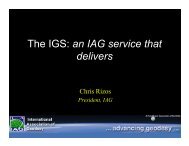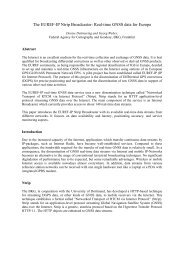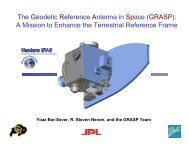IGS Analysis Center Workshop - IGS - NASA
IGS Analysis Center Workshop - IGS - NASA
IGS Analysis Center Workshop - IGS - NASA
You also want an ePaper? Increase the reach of your titles
YUMPU automatically turns print PDFs into web optimized ePapers that Google loves.
(c)(d)quality assessment and feedback to RAC’S and GAC’S, ultimately resulting in a better,more robust <strong>IGS</strong>. The problem of quality assessment for hundreds of stations per dayis daunting, but can be realistically achieved with a distributed system.Note that it expected that groups will serve in 2 or 3 of the above capacities,The system will accommodate those who have the most stringent accuracyrequirements. It will also accommodate those who have less stringent requirements, butcertain inputs to the system will have to at least meet certain accuracy standards. Indesign issues where there is a trade-off between achievable accuracy versus practicalissues such as computational burden, accuracy will have the highest weight except forcases where either (i) productivity y would be reduced to an intolerable level, or (ii) itwould be unreasonable to expect those affected to abide by the standard procedures. Inany case, accuracy must meet a specified standard (given below). Not meetingaccuracy standards should be regarded in the same way as a failure of a systemcomponent.The system will be designed so as not to limit regional baseline rrns accuracy to beworse than 5 mm + 10-8L in the horizontal components (where L is baseline length)and 20 mm + 1O-8L in the vertical component. For absolute coordinate accuracy (inthe global terrestrial frame), the system will be designed so as not to limit the rmspositioning accuracy to be worse than of 10 mm horizontal and 25 mm vertical. Theserequirements are to be interpreted as “anywhere on the globe,” and additionaldensification of the globaJ network maybe necessary.(e) The system will verify that the accuracy requirements are being met at several regionsthat tie well-distribu~ed around the globe, ~d provide sufficient feedback to analysiscenters for them to take appropriate action as necessary.(f)RAC’s and other users of <strong>IGS</strong> global products will be given the means to produceregional results that meet agreed upon standards. These means should include (but notbe limited to) sufficient information, recommendations, troubleshooting hints, feedbackprocedures, processing standards, possibly software tools and user guides, and ameans of assistance in case of inquiries and analysis questions.(g) There must be some standardized quantification of satellite orbit errors in <strong>IGS</strong> products,at least for those orbits that are degraded to the point that they will significantly affectregional baseline accuracy; and there needs to be explicit recommendations/instructionson how to use these indices for various user situations.(h) <strong>IGS</strong> will develop and provide the means for analysis centers and other users to easilyextract the standard coordinates of sites at an arbitrary epoch. This includes softwaretools, eccentricity information, phase center offsets, seismic displacements, andanything else that is pertinent.(i) <strong>IGS</strong> will develop explicit instructions, analysis standards, formats, recommendations,etc., to RAC’S and GAC’S who wish to submit their network solutions to <strong>IGS</strong> foreventual incorporation into the global network solution. Along with their solutions,region~ centers will provide <strong>IGS</strong> all pertinent information in some standard electronicform to be decided (e.g., assumed antenna heights, analysis strategy, etc.).67




